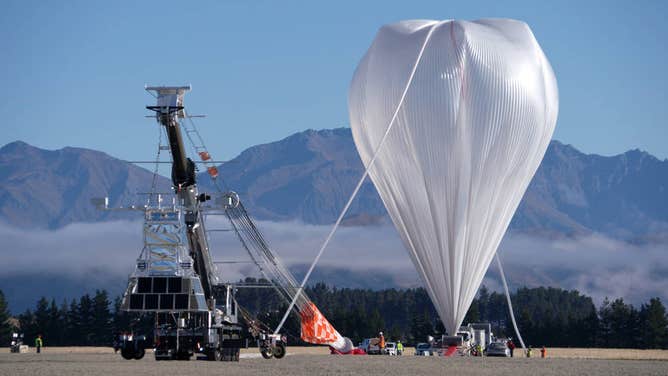A massive balloon that is circling the globe isn’t a Chinese spycraft. It’s a super balloon from NASA
The giant helium balloon is the size of a football field and is carrying a Super-pressure Balloon-borne Imaging Telescope (SuperBIT). Researchers say the telescope is capable of taking sharp images of distant galaxies.
New video shows how NASA launched a super balloon from New Zealand
A massive balloon is making its way across the globe, but it is all being done in the name of science. The NASA craft is carrying a Super-pressure Balloon-borne Imaging Telescope (SuperBIT). Researchers say the telescope is capable of taking sharp images of distant galaxies.
WĀNAKA, New Zealand – NASA scientists launched a football field-sized balloon Saturday from a remote area of New Zealand that the agency said was carrying a Super-pressure Balloon-borne Imaging Telescope (SuperBIT), which will travel around the Southern Hemisphere.
The launch of the 18.8-million-cubic-foot super-pressure balloon was part of a test mission that the agency hopes will be successful in cutting down costs by avoiding future rocket launches.
After the launch, the balloon ascended to the stratosphere, where upper levels winds were expected to help propel the flying laboratory around the globe for at least 100 days. According to NOAA, the stratosphere layer extends from around 10 miles to 31 miles above Earth's surface.

Technicians conduct a test of the SuperBIT payload in preparation for launch in New Zealand.
(FOX Weather)
HOW A SUSPECTED CHINESE SPY BALLOON IS DIFFERENT THAN AMERICA’S CLASSIC WEATHER BALLOON
Researchers at Princeton University said the telescope costs about $5 million – 1,000 times less than space-orbiting satellites.
While floating well above the cruising altitude of aircraft, the telescope will be taking images of galaxies and studying the mysterious substance known as dark matter in outer space.
"The super pressure balloon technology is a real game-changer for conducting cutting-edge science at the edge of space at a fraction of the cost of flying into space," Debbie Fairbrother, NASA’s balloon program office chief, said in a statement. "Some of the mind-blowing work planned this year includes a mission peering into space to study galaxy clusters and another looking at high-energy particles from beyond our galaxy."
ACCURATE FORECASTS WOULD BE ALMOST IMPOSSIBLE WITHOUT WEATHER BALLOONS
During its missions, researchers work to keep the massive balloons over international waters, but where land crossings are needed, the U.S. State Department helps coordinate country overflight approvals.
Unlike a space-based telescope that cannot leave orbit, a balloon’s equipment can be lowered through the atmosphere at any time for maintenance.
NASA said it has already launched three other balloons from New Zealand since 2015, with plans already in the works for additional craft.
A future balloon is expected to carry the Extreme Universe Space Observatory 2 project, which will detect and observe ultra-high energy cosmic-ray particles.
You can track the balloon’s movements in real-time here at csbf.nasa.gov.

Technicians from NASA’s Scientific Balloon Program perform solar array testing
(NASA)
